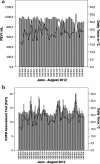Tele-monitoring reduces exacerbation of COPD in the context of climate change--a randomized controlled trial
- PMID: 24261700
- PMCID: PMC3883526
- DOI: 10.1186/1476-069X-12-99
Tele-monitoring reduces exacerbation of COPD in the context of climate change--a randomized controlled trial
Abstract
Background: A home based tele-monitoring system was developed to assess the effects of heat stress (days > 25°C) on clinical and functional status in patients with chronic obstructive pulmonary disease (COPD).
Methods: Sixty-two COPD patients (GOLD II-IV) were randomized into a tele-monitoring Group (TG, N = 32) or Control Group (CG, N = 30). Tele-monitoring included 1) daily clinical status (COPD Assessment Test-CAT), 2) daily lung function and 3) weekly 6-minute walk test (6MWT). Duration of monitoring lasted a total of nine months (9 M).
Results: From June 1st-August 31st 2012, 32 days with heat stress (29.0 ± 2.5°C) were recorded and matched with 32 thermal comfort days (21.0 ± 2.9°C). During heat stress, the TG showed a significant reduction in lung function and exercise capacity (FEV1% predicted: 51.1 ± 7.2 vs. 57.7 ± 5.0%; P <0.001 and 6MWT performance: 452 ± 85 vs. 600 ± 76 steps; P <0.001) and increase in CAT scores (19.2 ± 7.9 vs. 16.2 ± 7.2; P <0.001).Over summer, significantly fewer TG patients suffered exacerbation of COPD compared to CG patients (3 vs. 14; P = 0.006). Over entire 9 M follow-up, the TG group had fewer exacerbations compared to CG (7 vs. 22; P = 0.012), shorter cumulative hospital stay (34 vs. 97 days) and 43% fewer specialist consultations (24. vs. 42; P = 0.04).
Conclusion: Heat stress affects clinical and functional status in COPD. Tele-monitoring reduces exacerbation frequency and health care utilization during heat stress and other periods of the year.
Trial registration drks-id: DRK00000705.
Figures




References
-
- Michelozzi P, Accetta G, De SM, D’Ippoliti D, Marino C, Baccini M, Biggeri A, Anderson HR, Katsouyanni K, Ballester F, Bisanti L, Cadum E, Forsberg B, Forastiere F, Goodman PG, Hojs A, Kirchmayer U, Medina S, Paldy A, Schindler C, Sunyer J, Perucci CA. High temperature and hospitalizations for cardiovascular and respiratory causes in 12 European cities. Am J Respir Crit Care Med. 2009;12:383–389. doi: 10.1164/rccm.200802-217OC. - DOI - PubMed
-
- Michelozzi P, Kirchmayer U, Katsouyanni K, Biggeri A, McGregor G, Menne B, Kassomenos P, Anderson HR, Baccini M, Accetta G, Analytis A, Kosatsky T. Assessment and prevention of acute health effects of weather conditions in Europe, the PHEWE project: background, objectives, design. Environ Health. 2007;12:12. doi: 10.1186/1476-069X-6-12. - DOI - PMC - PubMed
Publication types
MeSH terms
Associated data
LinkOut - more resources
Full Text Sources
Other Literature Sources
Medical
Miscellaneous

